NUR-630 Performance Improvement and Quality in Health Care Course Assignments & Examples Study Guide
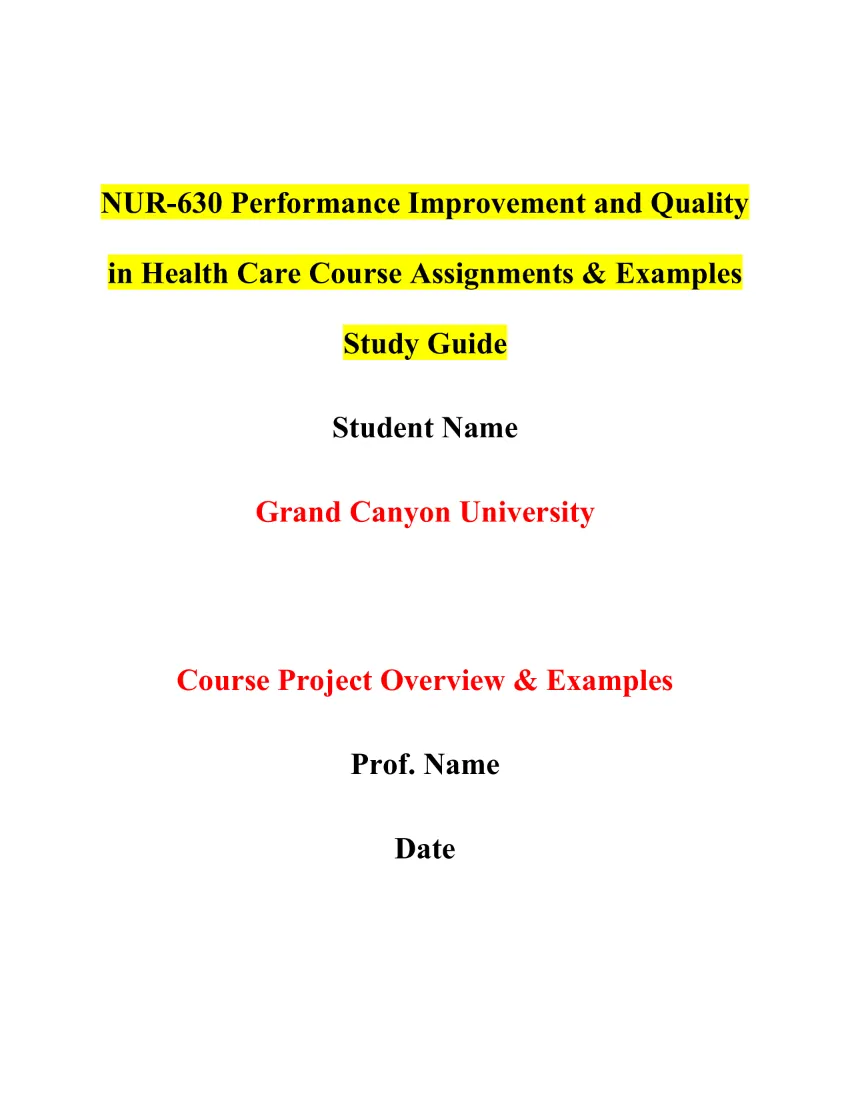 NUR-630 Performance Improvement and Quality in Health Care Course Description
NUR-630 Performance Improvement and Quality in Health Care Course Description
This course examines models of performance and quality improvement in health care. Learners differentiate measures of quality and learn to apply industry standard tools and process improvement methodology to enhance safety and positively impact patient outcomes and financial performance. Prerequisite: NUR-590
While all courses are completed online, you will need to attend clinical, practicum and immersion hours in person locally.
2 Mitchell, P. M. (n.d.). National Library of Medicine, Patient Safety and Quality: An Evidence-Based Handbook for Nurses. Retrieved Oct. 27, 2023.
NUR-630 Performance Improvement and Quality in Health Care GCU Entire Coursework Discussions & Assignments
- NUR 630 Topic 1 Assignment: Visual Model
- NUR 630 Topic 1 Discussion Question 1
- NUR 630 Topic 1 Discussion Question 2
- NUR 630 Topic 2 Assignment: Health Care Culture
- NUR 630 Topic 2 Discussion Question 1
- NUR 630 Topic 2 Discussion Question 2
- NUR 630 Topic 3 Discussion Question 1
- NUR 630 Topic 3 Discussion Question 2
- NUR 630 Topic 4 Assignment: CLC — Quality Models
- NUR 630 Topic 4 Discussion Question 1
- NUR 630 Topic 4 Discussion Question 2
- NUR 630 Topic 5 Assignment: Benchmark — Outcome and Process Measures
- NUR 630 Topic 5 Discussion Question 1
- NUR 630 Topic 5 Discussion Question 2
- NUR 630 Topic 6 Discussion Question 1
- NUR 630 Topic 6 Discussion Question 2
- NUR 630 Topic 7 Assignment: Benchmark — Hospital-Associated Infections Data
- NUR 630 Topic 7 Discussion Question 1
- NUR 630 Topic 7 Discussion Question 2
- NUR 630 Topic 8 Assignment: Overview of Quality in Health Care
- NUR 630 Topic 8 Discussion Question 1
- NUR 630 Topic 8 Discussion Question 2
NUR-630 Performance Improvement and Quality in Health Care GCU
NUR-630 Full Course Discussions
NUR 630 Topic 1 Discussion Question 1
Description:
You are assigned to a quality team on rehabilitation floor where patient falls are on the rise. What strategy would be best to approach this issue quality improvement, evidence-based practice, or research? Support your choice with one or two examples and one or two references.
NUR 630 Topic 1 Discussion Question 2
Description:
Some consider the integration of evidence-based practice a “cookbook” approach. Do you agree or disagree? Explain. Support your position with one or two examples and one or two references.
NUR 630 Topic 2 Discussion Question 1
Description:
Using the AHRQ “SOPS Surveys” webpage found in the topic materials, select the SOPS survey appropriate for practice setting in which you work. Complete the survey at your site and discuss how your facility scored. What changes would you recommend based on the survey results?
NUR 630 Topic 2 Discussion Question 2
Description:
Two nurses make a medication error: One causes an adverse event with a patient and other does not. Should the nurses be disciplined, and if so, should they be disciplined the same way? Why or why not? How would this be addressed in just culture?
NUR 630 Topic 3 Discussion Question 1
Description:
Your unit data reflects an upward trend in blood administration errors. It is likely an individual failure or a system failure? Which theory or model would you use to address it?
NUR 630 Topic 3 Discussion Question 2
Description:
Select a problem that you have experienced or identified within your workplace or in a health care setting. What steps would you take to address the problem?
NUR 630 Topic 4 Discussion Question 1
Description:
You are a member of an operating room team. The hospital is reporting an increase in the complication rates from your team. Choose one of the quality models and explain how you would use it to address the cause or adverse events.
NUR 630 Topic 4 Discussion Question 2
Description:
You are the nurse leader on an obstetrics unit. You have been tasked to utilize a Six Sigma approach for standardizing the discharge process. Where do you start?
NUR 630 Topic 5 Discussion Question 1
Description:
Measurement is required to determine the success of your CQI project. What is the difference between outcome and process measures? Which are more important? Why? Support your reasoning with an example.
NUR 630 Topic 5 Discussion Question 2
Description:
Identify which of the following approaches you would choose to assist in determining and measuring outcomes: FMEA, Pareto Principle, and control charts. Describe the best approach and explain why you chose it?
NUR 630 Topic 6 Discussion Question 1
Description:
What is the difference between primary and secondary data? How can primary and secondary source data be used to drive CQI? Provide a specific example of how each source can be used to drive CQI.
NUR 630 Topic 6 Discussion Question 2
Description:
Describe at least two limitations to both primary and secondary data and how understanding those limitations can improve your future CQI work.
NUR 630 Topic 7 Discussion Question 1
Description:
Identify at least two stakeholder agency reporting sources. How do these external reporting groups contribute to or hinder CQI?
NUR 630 Topic 7 Discussion Question 2
Description:
You are going to present data that has been collected to your administrative group. The focus is on outcome measures and the data collected is unplanned readmission rates at two different hospitals. What format would you choose to display your data and why? What information would you include with the data?
NUR 630 Topic 8 Discussion Question 1
Description:
What two elements do you believe play the most significant role in sustaining change and why? Support your answer with one or two references.
NUR 630 Topic 8 Discussion Question 2
Description:
The concept of a “Just Culture” has a number of key elements. Choose the two elements that you feel are the most difficult to achieve and provide one strategy for each that will make them achievable.
You can also read another study guide on nursing assignments for students from another post on NUR-631 Advanced Physiology and Pathophysiology Course Assignments & Examples.
NUR-630 Full Course Assignments
NUR-630 Topic 1 Visual Model
NUR 630 GCU The Differences Between Research QI & EBP in Nursing Presentation
Assessment Description
The purpose of this assignment is to differentiate quality improvement (QI), evidence-based practice (EBP), and research.
Create a graphic image or visual model differentiating quality improvement, evidence-based practice, and research. Please use PowerPoint, that creates a graphic. Be creative in your design. Include the following information in your graphic image or visual model:
- Compare and contrast quality improvement, evidence-based practice, and research. Identify at least one similarity and difference for each.
- Provide an example of quality improvement, evidence-based practice, and research.
- Explain why quality improvement, evidence-based practice, and research would be applied in a health care setting.
- This assignment requires a minimum of two scholarly sources.
While APA style is not required for the body of this assignment, solid academic writing is expected, and documentation of sources should be presented using APA formatting guidelines, which can be found in the APA Style Guide, located in the Student Success Center.
This assignment uses a rubric. Please review the rubric prior to beginning the assignment to become familiar with the expectations for successful completion.
You are not required to submit this assignment to LopesWrite.
NUR-630 Topic 2 Health Care Culture
NUR 630 Grand Canyon University Week 2 Health Care Culture Essay
Assessment Description
Health Care Culture
The purpose of this assignment is to discuss health care culture and describe how CWV can be used to improve ethical practices. In a 1,000-1,250 word essay, discuss the important factors associated with health care culture. Include the following in your essay:
- A definition of health care culture, including culture of excellence and safety.
- Two or three examples of principles for building a culture of excellence and safety.
- An explanation of the role of various stakeholders in improving health care culture.
- An explanation of how Christian worldview (CWV) principles might be used by health care organizations to improve ethical practices, whether they are Christian or not.
- Two or three examples of how the integration of faith learning and work at GCU can be implemented by individuals to improve health care culture.
This assignment requires a minimum of three scholarly sources.
Prepare this assignment according to the guidelines found in the APA Style Guide, located in the Student Success Center. An abstract is not required.
This assignment uses a rubric. Please review the rubric prior to beginning the assignment to become familiar with the expectations for successful completion.
You are required to submit this assignment to LopesWrite. A link to the LopesWrite technical support articles is located in Class Resources if you need assistance.
NUR-630 Topic 3 CLC – CLC Agreement
Grand Canyon University Nursing Theory and Conceptual Model Presentation
Assessment Description
| CLC – Nursing Theory and Conceptual Model Presentation |
|
This is a Collaborative Learning Community (CLC) assignment.
This assignment is to be completed in a group, which will be assigned by your instructor. The presentation will be submitted and graded as a group assignment.
Nursing theories are tested and systematic ways to implement nursing practice. Select a nursing theory and its conceptual model. Prepare a 10‐15 slide PowerPoint in which you describe the nursing theory and its conceptual model and demonstrate its application in nursing practice. Include the following:
- Present an overview of the nursing theory. Provide evidence that demonstrates support for the model’s efficacy in nursing practice. Explain how the theory proves the conceptual model.
- Explain how the nursing theory incorporates the four metaparadigm concepts.
- Provide three evidence‐based examples that demonstrate how the nursing theory supports nursing practice. Provide support and rationale for each.
Refer to the resource, “Creating Effective PowerPoint Presentations,” located in the Student Success Center, for additional guidance on completing this assignment in the appropriate style.
While APA style is not required for the body of this assignment, solid academic writing is expected, and documentation of sources should be presented using APA formatting guidelines, which can be found in the APA Style Guide, located in the Student Success Center.
This assignment uses a rubric. Please review the rubric prior to beginning the assignment to become familiar with the expectations for successful completion.
You are required to submit this assignment to LopesWrite. Refer to the LopesWrite Technical Support articles for assistance.
Noted: This is a group assignment, we have to submit it in group, and I am only responsible for this part:
3- Provide three evidence‐based examples that demonstrate how the nursing theory supports nursing practice. Provide support and rationale for each.
NUR-630 Topic 4 CLC – Quality Models
NUR 630 Grand Canyon Week 4 Quality Model Applied in Healthcare Presentation
Assessment Description
This is a Collaborative Learning Community (CLC) assignment.
Meet with your instructor-assigned group to review the Topic 4 assignment and familiarize yourselves with the expectations for the project.
Fill out the attached “CLC Agreement” form and submit it to the instructor.
The purpose of this assignment is to examine quality models used in health care. With your CLC group, create a 10-15 slide PowerPoint on Lean, Six Sigma, and 5S quality models. Include the following in your presentation:
- A description of each quality model.
- A brief history of each quality model.
- A description and examples of how each quality model can be applied to the health care setting.
- Include a title slide, references slide, and comprehensive speaker notes.
- Use a minimum of four peer-reviewed, scholarly references as evidence.
Refer to the resource, “Creating Effective PowerPoint Presentations,” located in the Student Success Center, for additional guidance on completing this assignment in the appropriate style.
While APA style is not required for the body of this assignment, solid academic writing is expected, and documentation of sources should be presented using APA formatting guidelines, which can be found in the APA Style Guide, located in the Student Success Center.
This assignment uses a rubric. Please review the rubric prior to beginning the assignment to become familiar with the expectations for successful completion.
You are not required to submit this assignment to LopesWrite.
NUR-630 Topic 5 Benchmark – Outcome and Process Measures
GCU Outcome and Process Measures used for CQI Research Paper
Assessment Description
In a 1,000-1,250 word paper, consider the outcome and process measures that can be used for CQI. Include the following in your essay:
- At least two process measures that can be used for CQI.
- At least one outcome measure that can be used for CQI.
- A description of why each measure was chosen.
- An explanation of how data would be collected for each (how each will be measured).
- An explanation of how success would be determined.
- One or two data-driven, cost-effective solutions to this challenge.
Use a minimum of three peer-reviewed scholarly references as evidence.
Prepare this assignment according to the guidelines found in the APA Style Guide, apa 7th edition, located in the Student Success Center. An abstract is not required. Please use at least 4 sources.
This assignment uses a rubric. Please review the rubric prior to beginning the assignment to become familiar with the expectations for successful completion.
You are required to submit this assignment to LopesWrite. A link to the LopesWrite technical support articles is located in Class Resources if you need assistance.
Benchmark Information
This benchmark assignment assesses the following programmatic competency:
MSN Emphasis in Leadership in Health Care Systems
6.5 Generate data-driven, cost-effective solutions to organizational challenges.
Benchmark – Outcome and Process
Measures
https://support.gcu.edu/hc/en-us/sections/360001963394-LopesWrite
https://support.gcu.edu/hc/en-us/sections/360001963394-LopesWrite
NUR-630 Topic 6 Quality Data Sources
Assessment
The purpose of this assignment is to become familiar with various data sources used by health care organizations to obtain quality data. The Agency for Healthcare Research and Quality (AHRQ) creates an annual report, the National Healthcare Quality and Disparities Report, which assesses the performance of the U.S. health care system. This report identifies strengths and weaknesses of the health care system in addition to disparities for access to health care and quality of health care. The report is based on more than 250 measures of quality and disparities, and it covers a broad range of health care services and settings.
Access the most current report using the “National Healthcare Quality and Disparities Reports” AHRQ website https://www.ahrq.gov/research/findings/nhqrdr/nhqdr17/index.html , provided in the topic Resources. Select five data sources from this report and fill in the required components on the “Quality Data Sources Organizer.”
While APA style is not required for the body of this assignment, solid academic writing is expected, and documentation of sources should be presented using APA formatting guidelines, which can be found in the APA Style Guide, located in the Student Success Center.
This assignment uses a rubric. Please review the rubric prior to beginning the assignment to become familiar with the expectations for successful completion.
You are not required to submit this assignment to LopesWrite.
Rubric
Quality Data Sources – Rubric
Data Source 1
14.4 points
Data Source 2
14.4 points
Data Source 3
14.4 points
Data Source 4
14.4 points
Data Source 5
14.4 points
Mechanics of Writing
4 points
Format/Documentation
4 points
Total 80 points
Quality Data Sources Organizer
| Data Source | Primary Content | Population Targeted | Demographic Data | Schedule | Is This a Source of Primary or Secondary Data? | How / When / Where the Information Might Be Used |
NUR-630 Topic 7 Benchmark – Hospital-Associated Infections Data
GCU Hospital Associated Infections Data Presentation
Assessment Description
The purpose of this assignment is to examine health care data on hospital-associated infections and determine the best methods for presenting the data to stakeholders. Use the scenario below and the “Hospital Associated Infections Data” Excel spreadsheet to complete the assignment.
Scenario
You have been tasked with displaying Centers for Medicare and Medicaid Services (CMS) hospital quality measures data for a 5-year period on four quality measures at your site. After examining the data, identify trends and determine the best way to present the actionable information to stakeholders.
Assignment
Create a 10-15 slide PowerPoint presenting the data to the stakeholders. Address the following in your PowerPoint:
- What conclusions can be drawn for each quality measure over the 5-year period?
- What trends do you see for each quality measure over the 5-year period?
- When comparing each quality measure, is the quality measure better than, worse than, or no different from the national benchmark over time?
- Based on your examination of the data, which of the quality measures should you prioritize and why?
- Develop a quality improvement metric and related measures to improve care processes, outcomes, and the patient experience relating to the identified area of opportunity.
- Explain how you would monitor the metric and use collected data for improvement.
Include a title slide, references slide, and comprehensive speaker notes.
Refer to the resource, “Creating Effective PowerPoint Presentations,” located in the Student Success Center, for additional guidance on completing this assignment in the appropriate style.
Use a minimum of two peer-reviewed, scholarly sources as evidence.
While APA style is not required for the body of this assignment, solid academic writing is expected, and documentation of sources should be presented using APA formatting guidelines, which can be found in the APA Style Guide, located in the Student Success Center.
This assignment uses a rubric. Please review the rubric prior to beginning the assignment to become familiar with the expectations for successful completion.
You are not required to submit this assignment to LopesWrite.
Benchmark Information
This benchmark assignment assesses the following programmatic competency:
MSN Emphasis in Leadership in Health Care Systems
6.6 Develop and monitor continuous quality improvement metrics and measures to improve care processes, outcomes, and the patient experience.
NUR-630 Topic 8 Overview of Quality in Health Care
NUR 630 Grand Canyon University Quality or Patient Safety Concern Paper
Assessment Description
The purpose of this assignment is to apply the concepts you have learned in this course to a situation you have encountered. Choose one quality or patient safety concern with which you are familiar and that you have not yet discussed in this course. In a 1,250-1,500 word essay, reflect on what you have learned in this course by applying the concepts to the quality or patient safety concern you have selected. Include the following in your essay:
- Briefly describe the issue and associated challenges.
- Explain how EBP, research, and PI would be utilized to address the issue.
- Explain the PI or QI process you would apply and discuss why you chose it.
- Describe your data sources, including outcome and process data.
- Explain how the data will be captured and disseminated.
- Discuss which organizational culture considerations will be essential to the success of your work.
This assignment uses a rubric. Please review the rubric prior to beginning the assignment to become familiar with the expectations for successful completion.
Use a minimum of four peer-reviewed, scholarly sources as evidence.
Prepare this assignment according to the guidelines found in the APA Style Guide, located in the Student Success Center. An abstract is not required.
You are required to submit this assignment to LopesWrite. A link to the LopesWrite Technical Support articles is located in Class Resources if you need assistance.
Get The Best Nursing Paper Writing Service and Unlock Your Academic Success
Are you overwhelmed with complex nursing assignments, tight deadlines, or specific instructions that seem challenging to meet? Look no further – nursingcustomwriting.com is your go-to destination for all your nursing paper writing needs! Our expert nursing essay writers are dedicated to providing you with high-quality, original, and customized nursing papers that guarantee the best grades possible.
Why choose nursingcustomwriting.com?
- Professional Nursing Writers: Our team of professional writers specializes in nursing essay papers, ensuring your assignment is in the hands of experts who understand the writing of nursing topics.
- Affordable Prices: We understand the financial constraints of college students. Our online nursing papers are available at very cheap prices, making our services accessible to all. Whether you need assistance with nursing coursework writing, want to buy a nursing essay online, or are in search of reliable nursing assignment help, we’ve got you covered.
- Customized Nursing Paper Solutions: Whether you need assistance with a complex topic, have a tight deadline, or are seeking a guide on how to write your nursing assignment, we’ve got you covered. Our writers will tailor their approach to meet your specific needs.
- Originality Guaranteed: Say goodbye to plagiarized papers! Our writers will provide you with an outstanding nursing essay paper written from scratch, ensuring it adheres to any topic, deadline, and instructions you provide.
Save your time for what matters most and let nursingcustomwriting.com take care of your essay. Don’t settle for subpar papers or risk submitting plagiarized content. Choose the best nursing paper writing service today!
Unlock your academic success by trusting nursingcustomwriting.com – Your Partner in Excellence.


 NUR-621 Principles of health Care Financial Management Course Description
NUR-621 Principles of health Care Financial Management Course Description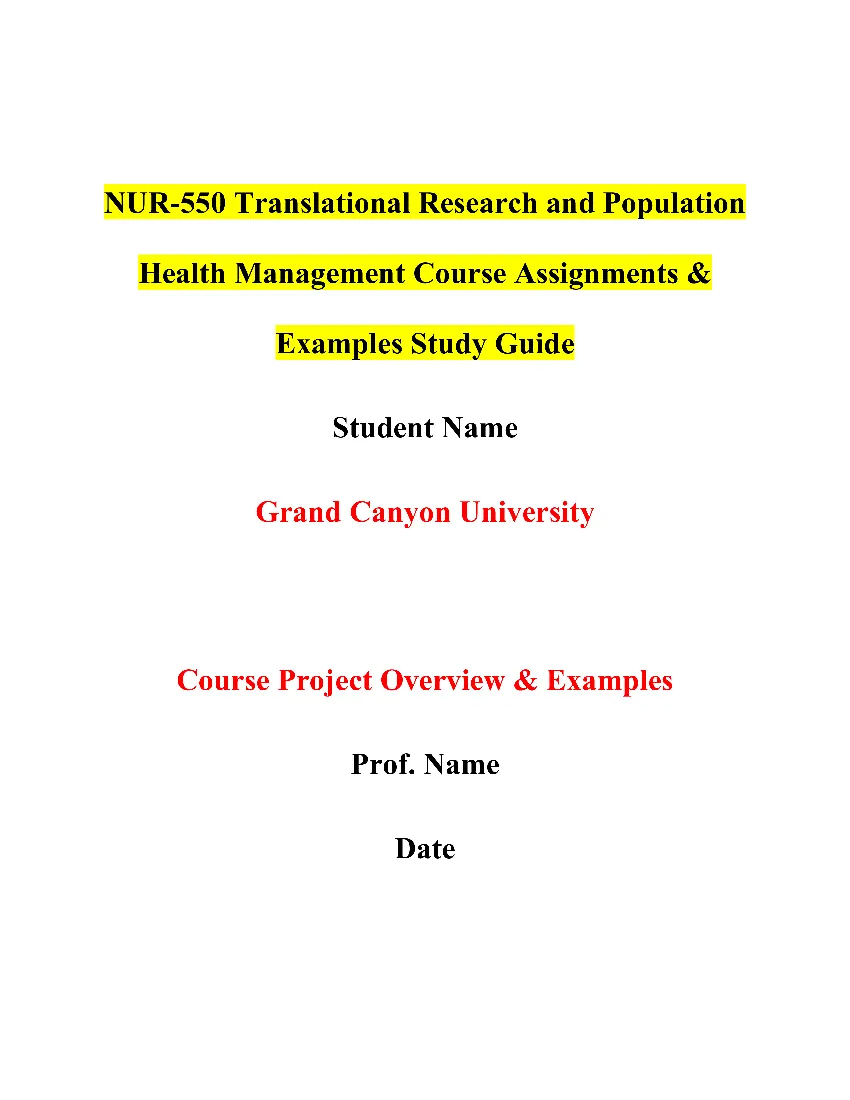 NUR-550 Translational Research and Population Health Management Course Description
NUR-550 Translational Research and Population Health Management Course Description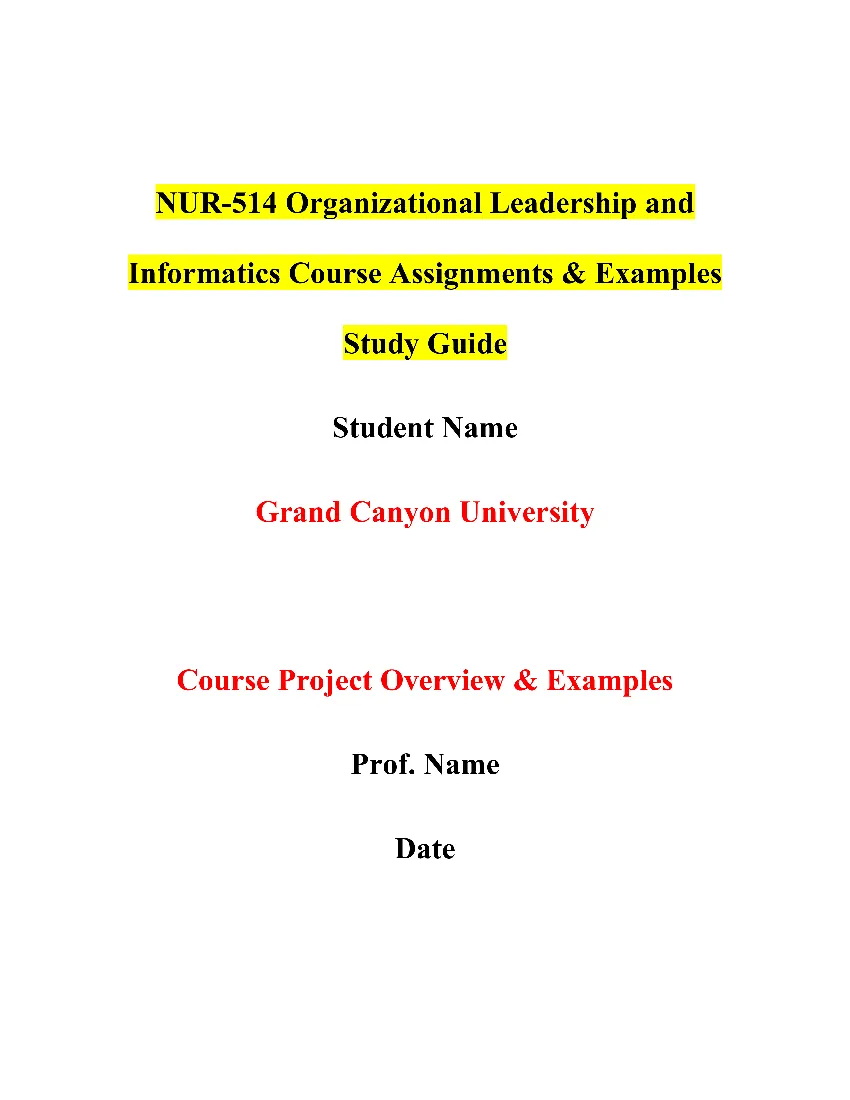 NUR-514 Organizational Leadership and Informatics Course Description
NUR-514 Organizational Leadership and Informatics Course Description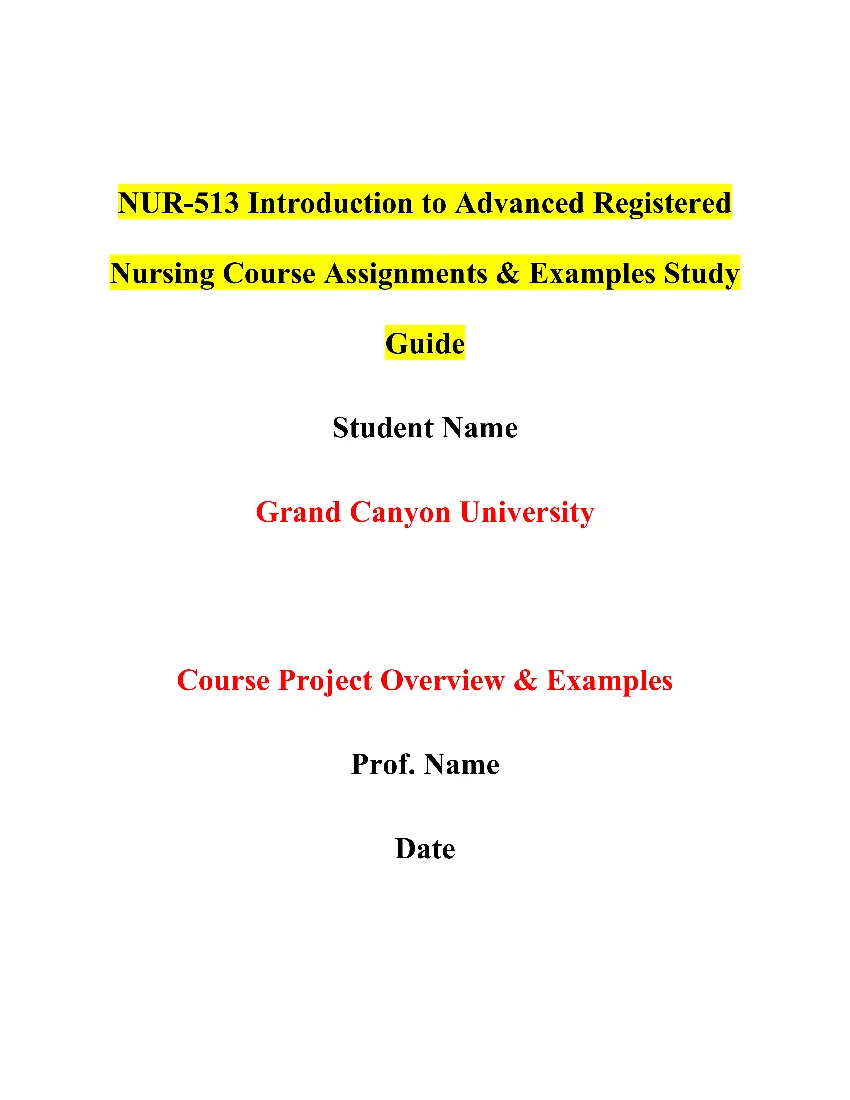 NUR-513 Introduction to Advanced Registered Nursing Course Description
NUR-513 Introduction to Advanced Registered Nursing Course Description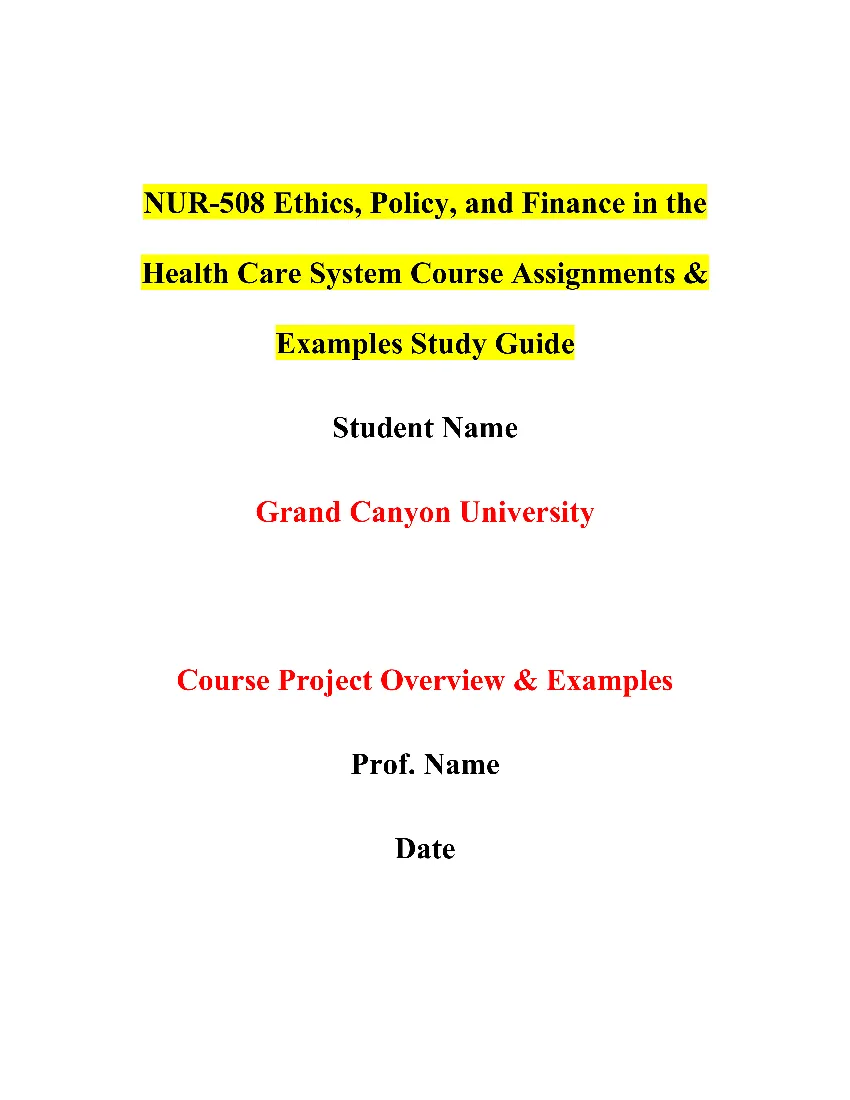 NUR-508 Ethics, Policy, and Finance in the Health Care System Course Description
NUR-508 Ethics, Policy, and Finance in the Health Care System Course Description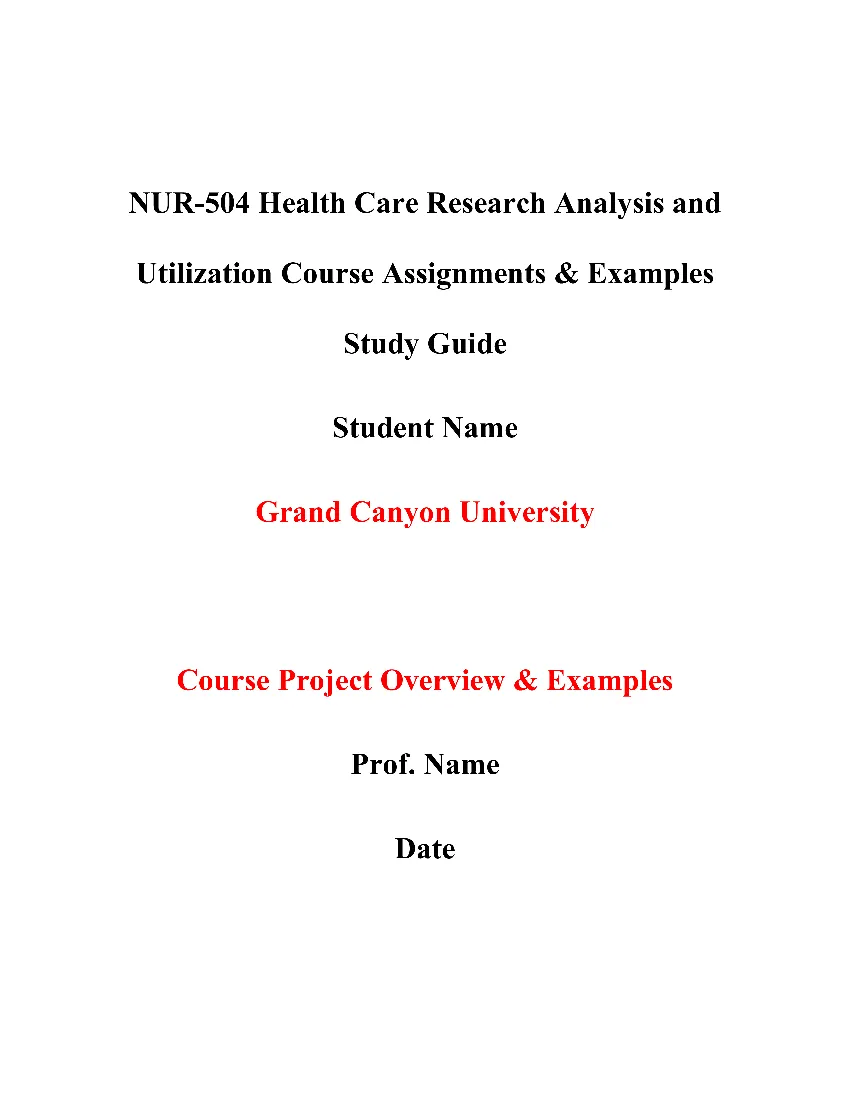 NUR-504 Health Care Research Analysis and Utilization Course Description
NUR-504 Health Care Research Analysis and Utilization Course Description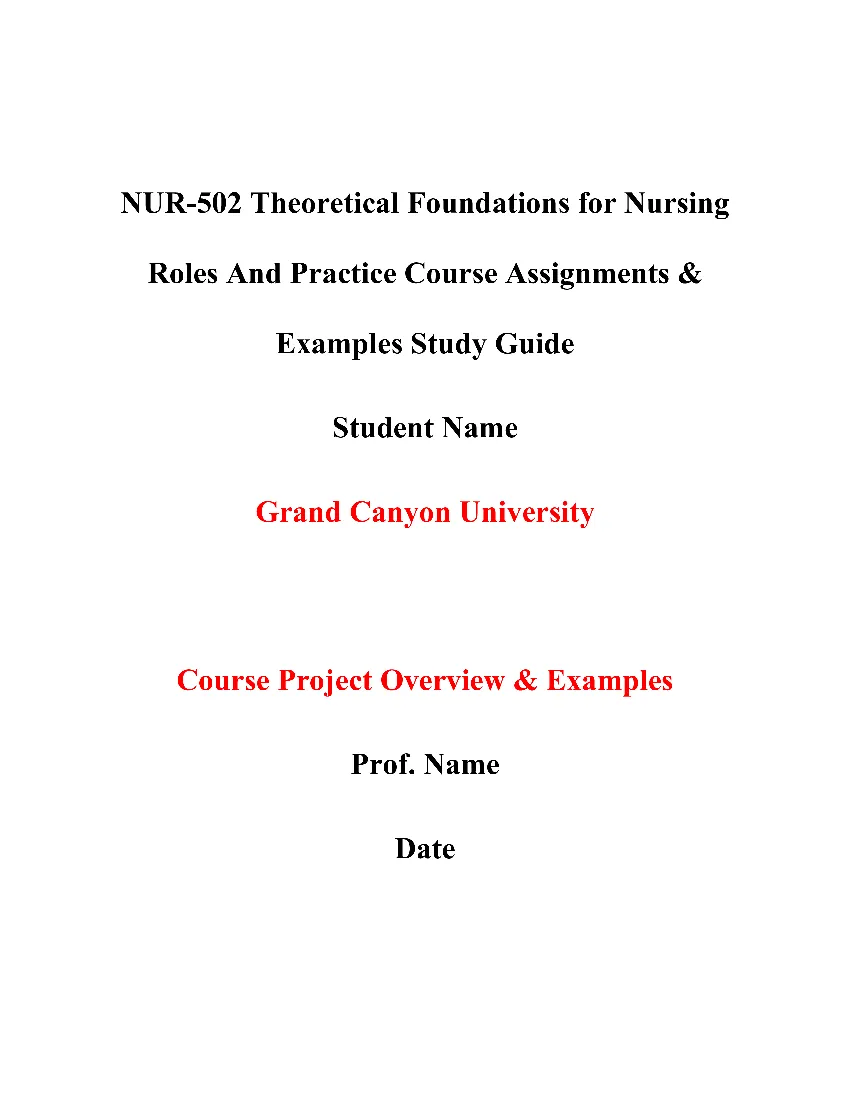 NUR-502 Theoretical Foundations for Nursing Roles and Practice Course Description
NUR-502 Theoretical Foundations for Nursing Roles and Practice Course Description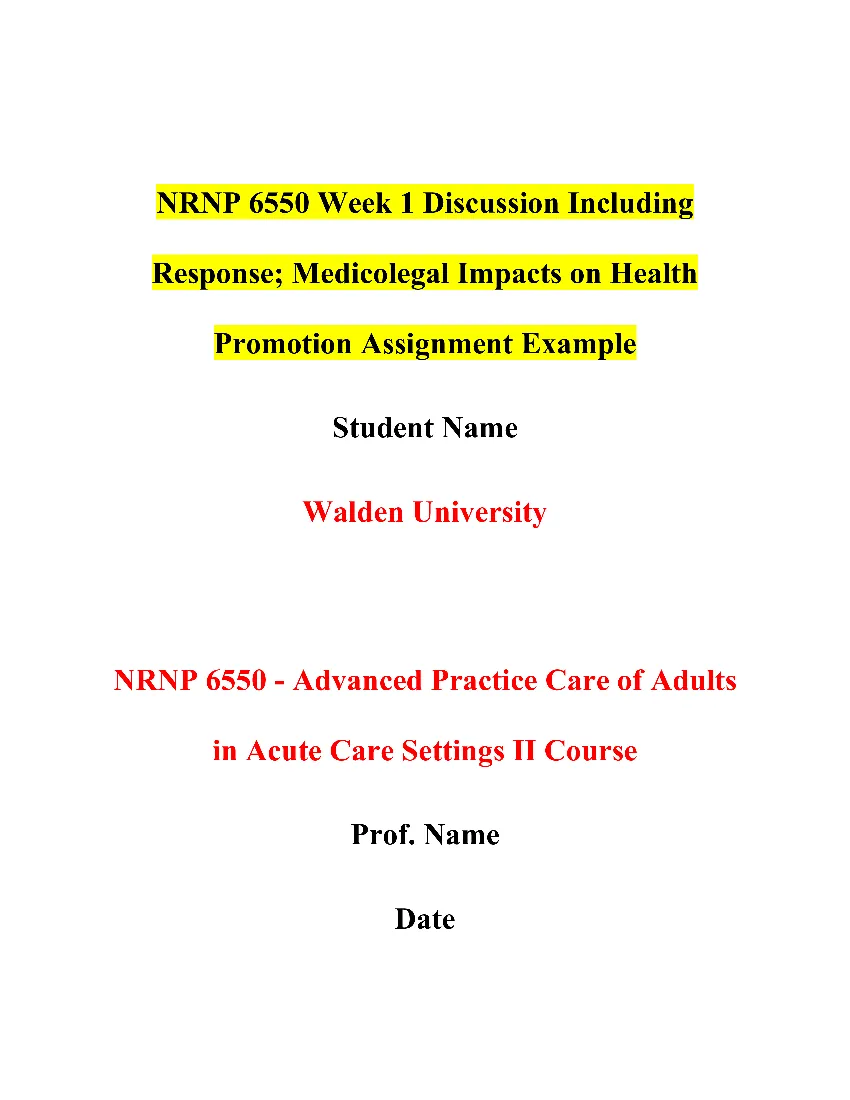 NRNP 6550 Week 1 Discussion Including Response; Medicolegal Impacts on Health Promotion Assignment
NRNP 6550 Week 1 Discussion Including Response; Medicolegal Impacts on Health Promotion Assignment NRNP 6550 – Advanced Practice Care of Adults in Acute Care Settings II (3 credits)
NRNP 6550 – Advanced Practice Care of Adults in Acute Care Settings II (3 credits)